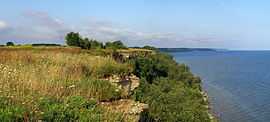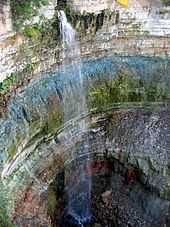Baltic Klint

The Baltic Klint (Clint, Glint; Estonian: Balti klint, Russian: Балтийско-Ладожский уступ, Глинт) is an erosional limestone escarpment on several islands of the Baltic Sea, in Estonia and in Leningrad Oblast of Russia. It is featured on the reverse of the Estonian 100 krooni note.
Geography
The Baltic Klint extends approximately 1200 km from the island of Öland in Sweden through the continental shelf and the Estonian islands of Osmussaar and Suur-Pakri to Paldiski, then along the southern shore of the Gulf of Finland and Neva River to the area south of Lake Ladoga in Russia, where it disappears under younger sedimentary deposits.
The cliff reaches 55.6 m above sea level at its highest at Ontika, Kohtla Parish, Ida-Viru County of Estonia. It is cut by numerous rivers (including the Narva, Luga, Izhora and the Tosna), many of which form waterfalls and rapids. The Valaste Waterfall (in Kohtla Parish) with a drop of 25 m is the highest.
See also
References
External links
| Wikimedia Commons has media related to Baltic Klint. |
